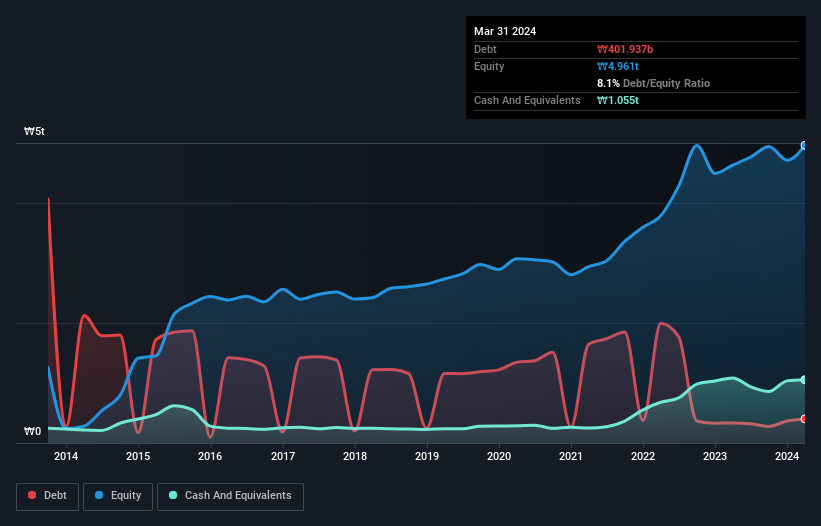- South Korea
- /
- Marine and Shipping
- /
- KOSE:A028670
Pan Ocean (KRX:028670) Takes On Some Risk With Its Use Of Debt
Howard Marks put it nicely when he said that, rather than worrying about share price volatility, 'The possibility of permanent loss is the risk I worry about... and every practical investor I know worries about.' So it seems the smart money knows that debt - which is usually involved in bankruptcies - is a very important factor, when you assess how risky a company is. As with many other companies Pan Ocean Co., Ltd. (KRX:028670) makes use of debt. But the more important question is: how much risk is that debt creating?
What Risk Does Debt Bring?
Generally speaking, debt only becomes a real problem when a company can't easily pay it off, either by raising capital or with its own cash flow. In the worst case scenario, a company can go bankrupt if it cannot pay its creditors. However, a more common (but still painful) scenario is that it has to raise new equity capital at a low price, thus permanently diluting shareholders. Of course, the upside of debt is that it often represents cheap capital, especially when it replaces dilution in a company with the ability to reinvest at high rates of return. When we examine debt levels, we first consider both cash and debt levels, together.
Check out our latest analysis for Pan Ocean
How Much Debt Does Pan Ocean Carry?
You can click the graphic below for the historical numbers, but it shows that as of March 2024 Pan Ocean had ₩401.9b of debt, an increase on ₩334.2b, over one year. However, its balance sheet shows it holds ₩1.05t in cash, so it actually has ₩652.8b net cash.

How Healthy Is Pan Ocean's Balance Sheet?
Zooming in on the latest balance sheet data, we can see that Pan Ocean had liabilities of ₩1.30t due within 12 months and liabilities of ₩2.06t due beyond that. Offsetting these obligations, it had cash of ₩1.05t as well as receivables valued at ₩230.9b due within 12 months. So its liabilities outweigh the sum of its cash and (near-term) receivables by ₩2.08t.
This is a mountain of leverage relative to its market capitalization of ₩2.17t. Should its lenders demand that it shore up the balance sheet, shareholders would likely face severe dilution. While it does have liabilities worth noting, Pan Ocean also has more cash than debt, so we're pretty confident it can manage its debt safely.
Shareholders should be aware that Pan Ocean's EBIT was down 49% last year. If that decline continues then paying off debt will be harder than selling foie gras at a vegan convention. When analysing debt levels, the balance sheet is the obvious place to start. But ultimately the future profitability of the business will decide if Pan Ocean can strengthen its balance sheet over time. So if you want to see what the professionals think, you might find this free report on analyst profit forecasts to be interesting.
Finally, while the tax-man may adore accounting profits, lenders only accept cold hard cash. Pan Ocean may have net cash on the balance sheet, but it is still interesting to look at how well the business converts its earnings before interest and tax (EBIT) to free cash flow, because that will influence both its need for, and its capacity to manage debt. Happily for any shareholders, Pan Ocean actually produced more free cash flow than EBIT over the last three years. That sort of strong cash conversion gets us as excited as the crowd when the beat drops at a Daft Punk concert.
Summing Up
While Pan Ocean does have more liabilities than liquid assets, it also has net cash of ₩652.8b. And it impressed us with free cash flow of ₩259b, being 111% of its EBIT. So although we see some areas for improvement, we're not too worried about Pan Ocean's balance sheet. There's no doubt that we learn most about debt from the balance sheet. But ultimately, every company can contain risks that exist outside of the balance sheet. Case in point: We've spotted 3 warning signs for Pan Ocean you should be aware of.
If you're interested in investing in businesses that can grow profits without the burden of debt, then check out this free list of growing businesses that have net cash on the balance sheet.
New: Manage All Your Stock Portfolios in One Place
We've created the ultimate portfolio companion for stock investors, and it's free.
• Connect an unlimited number of Portfolios and see your total in one currency
• Be alerted to new Warning Signs or Risks via email or mobile
• Track the Fair Value of your stocks
Have feedback on this article? Concerned about the content? Get in touch with us directly. Alternatively, email editorial-team (at) simplywallst.com.
This article by Simply Wall St is general in nature. We provide commentary based on historical data and analyst forecasts only using an unbiased methodology and our articles are not intended to be financial advice. It does not constitute a recommendation to buy or sell any stock, and does not take account of your objectives, or your financial situation. We aim to bring you long-term focused analysis driven by fundamental data. Note that our analysis may not factor in the latest price-sensitive company announcements or qualitative material. Simply Wall St has no position in any stocks mentioned.
Have feedback on this article? Concerned about the content? Get in touch with us directly. Alternatively, email editorial-team@simplywallst.com
About KOSE:A028670
Pan Ocean
Provides marine transportation and other related services worldwide.
Undervalued with excellent balance sheet.
Similar Companies
Market Insights
Community Narratives



